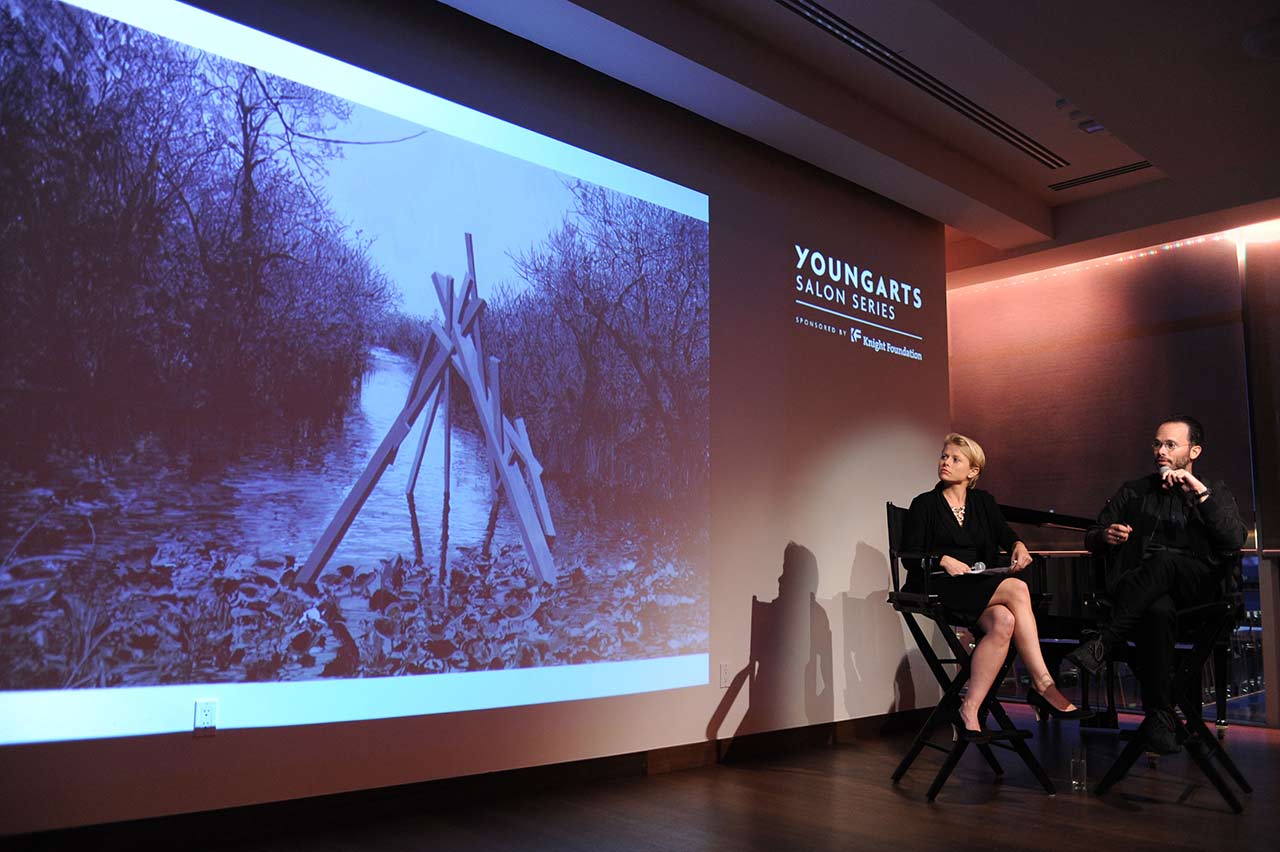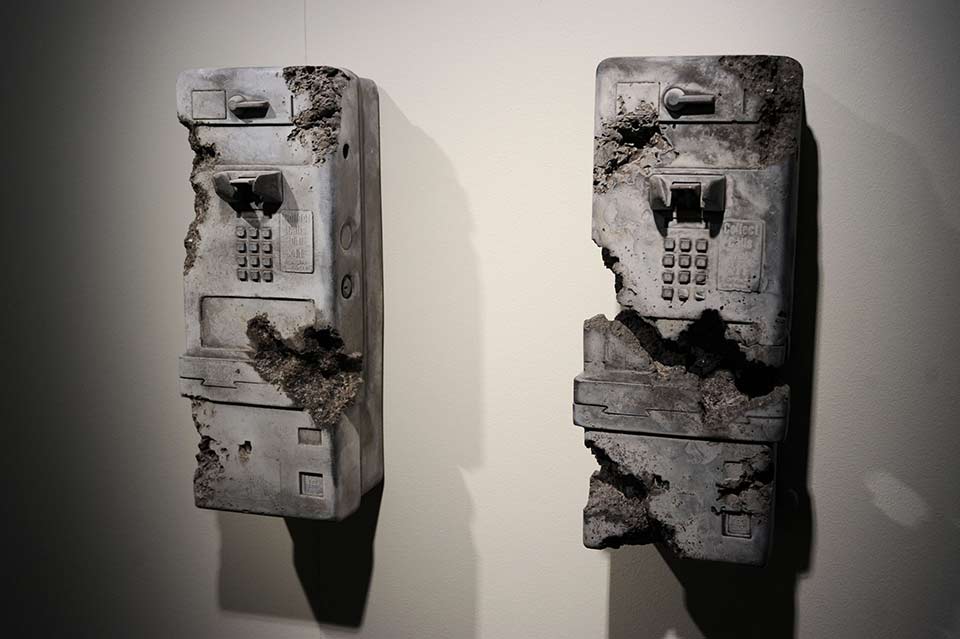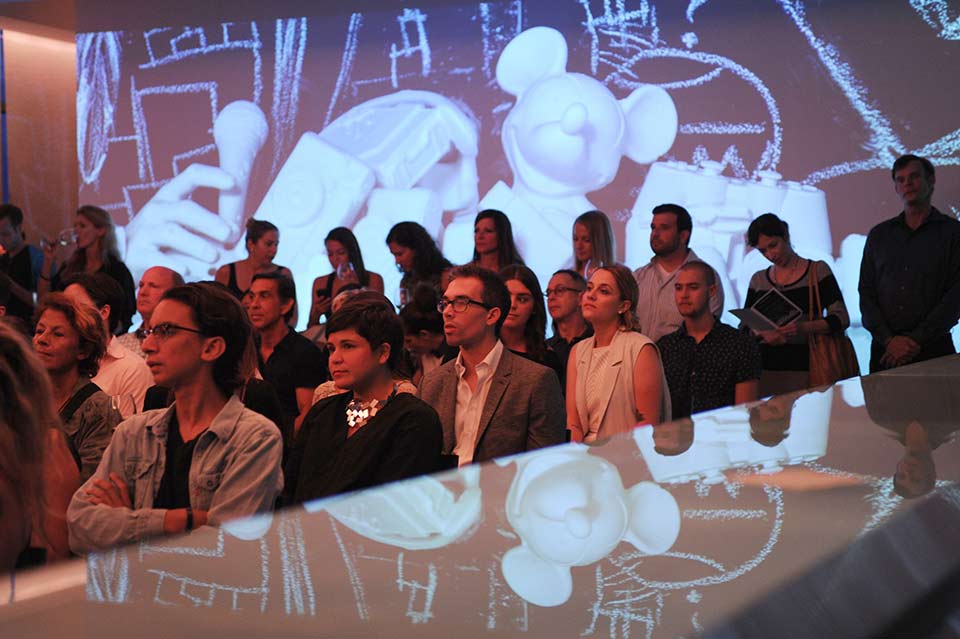
Daniel Arsham and the future that was, now and then
Photo credit: World Red Eye.
The first floor gallery at the headquarters of the National YoungArts Foundation in Miami suggested an archeological site Thursday. There were mounds of seemingly freshly unearthed artifacts, ghostly white chalk replicas of objects that, not that long ago, were the symbols of modernity: Walkmans, Polaroid cameras, BlackBerrys, boom boxes, the bodies of Fender Stratocaster guitars and video cameras. This was the future then. Now visitors use pieces of that past-turned-chalk to write on the black walls about the next future. It’s now there, in words and drawings, some already blurred, some already covered by other writing.
On the second floor, replicas of a couple of pay phones, a rack of basketballs, a flag and an electric guitar are shown like archeological pieces — broken, pieces ripped and torn.
The overall effect is made stronger by the fact that these are all ordinary yet iconic objects, cultural markers of yesterday’s invincible future.
“This is not just any Polaroid camera; it’s the one that we all remember,” said visual artist Daniel Arsham, picking up a chalk replica while playing guide to a group of visitors to the “site.” “All the objects were selected with that in mind. And upstairs there are other works; those are made of geological materials like volcanic ash, crystal and elements which really convey the sense of time.”

Photo credit: World Red Eye.
“The Future Was Written,” an exhibit by YoungArts alum Arsham curated by Franklin Sirmans, the incoming director of the Pérez Art Museum Miami, opened Thursday at YoungArts. Arsham and Sirmans were also part of the first installment this season of the Young Arts Salon Series, sponsored by Knight Foundation. The two events were part of the second annual YoungArts Awareness Day, a national effort to encourage emerging artists to pursue careers in the arts.
Sirmans, who was in Los Angeles, participated briefly via Skype. He spoke of his work at the Los Angeles County Museum of Art and at the Menil Collection in Houston, and of having had “the opportunity to see and learn from two very different, but what I consider, the best viewpoints and mentors. So I’ve been looking forward to this transition… and then to have the opportunity to work with the incredible curatorial team at the Pérez makes it so much easier. I can’t wait to see [Arsham’s] installation and see everybody in Miami next month.” Sirmans is scheduled to assume his post at the museum Oct. 15.
The conversation then continued between Arsham and curator and moderator Claire Breukel.
Born in Ohio and raised in Miami, Arsham attended the Design and Architecture High School before moving to New York to attend Cooper Union (“I was initially rejected,” Arsham noted) but he returned to Miami. Arsham and three other artists — Bhakti Baxter, Martin Oppel and Tao Rey — rented a house “just across the street from here” (the two-story home was at 2330 NE Fourth Ave., little more than two blocks from Young Arts headquarters) that had an exhibition space in the first floor. The House, as it was simply known, eventually had its own show at North Miami’s Museum of Contemporary Art. In 2005, dancer and choreographer Merce Cunningham saw his work and called him to develop the stage design for his next project, “eyeSpace.” It was a turning point in Arsham’s career.
“Of course, I knew who Merce was,” he recalled Thursday. “But I was not familiar with his dance. I’ve never even been on stage before. Merce had a very particular way of working. He would create his choreography, an artist would create the set and a musician would write the score — but none of us knew what the other one was doing and we would throw it together and see what happened, which was both amazing and terrifying.” He collaborated and toured with Cunningham, until the choreographer’s death in 2009.

Photo credit: World Red Eye.
Using a slide presentation, Arsham discussed different periods in broad strokes, at one point marking a trip to Easter Island in 2010 as the origin of his fictional archaeology. He was painting, he recalled, but because he stayed longer than the usual visitor he had the opportunity to engage with the locals and the archaeologists working on the island. And as it turned out, “when they were excavating, they found things around the site that previous archaeologist had left — and they treated them the same as if they were the original object. So there was this very strange confusion of time … that broadened the view of time and history. [It is] something that I want to bring into my work.”
As for the then and now of Miami, in a conversation before the talk, Arsham, who lives in New York, conceded that while he is not “totally familiar with what is happening here, I do see organizations like Cannonball and Locust [Projects], and YoungArts, trying to continually encourage art to happen here. What I don’t think Miami has done a particularly good job in is in creating a scenario which encourages artists to stay here and create a career here. I left because there were many things that I wanted to do that I really couldn’t have done from here. … But in some ways it was easier for me to get to the right place in New York after having come back here.”
Fernando González is a Miami-based arts and culture writer. He can be reached via email at [email protected].

Photo credit: World Red Eye.
Recent Content
-
Artsarticle ·
-
Artsarticle ·
-
Artsarticle ·
